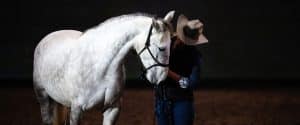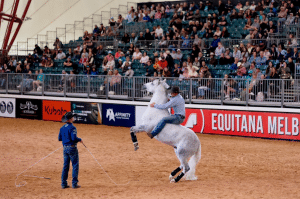𝗪𝗵𝗲𝗻 𝘁𝗼 𝗳𝗲𝗲𝗱 𝗮 𝗴𝗿𝗮𝗶𝗻 𝗳𝗿𝗲𝗲 𝗳𝗲𝗲𝗱?
Knowing what is best for your horse can be tricky, at Pryde’s we understand that each horse is an individual and should be fed as such. So deciding whether your horse needs a grain free feed or not is going to depend on their individual needs and we hope the below can help.
𝗙𝗶𝗿𝘀𝘁𝗹𝘆, 𝘄𝗵𝗮𝘁 𝗶𝘀 𝗴𝗿𝗮𝗶𝗻 𝗳𝗿𝗲𝗲?
A truly grain free feed is one that is free of both whole grains such as corn, barley and wheat as well as grain by products such as mill mix, bran or pollard. Instead the feed is based on fibre and fat sources such as lucerne leaf meal, legume hulls and oil.
The main difference between a grain-based feed and a grain free feed are the sources of digestible energy they contain. Grain based feeds tend to be higher in starch and sugars (non-structural carbohydrates) which are absorbed as glucose into the bloodstream from the small intestine – resulting in an increase in blood glucose levels. While grain free feeds are much lower in starch and sugar and don’t result in a high peak of blood glucose levels.
𝗧𝗵𝗲𝗿𝗲 𝗮𝗿𝗲 𝘁𝗶𝗺𝗲𝘀 𝘄𝗵𝗲𝗻 𝗵𝗼𝗿𝘀𝗲𝘀 𝗺𝘂𝘀𝘁 𝗯𝗲 𝗳𝗲𝗱 𝗮 𝗴𝗿𝗮𝗶𝗻 𝗳𝗿𝗲𝗲, 𝗹𝗼𝘄 𝘀𝘁𝗮𝗿𝗰𝗵 𝗮𝗻𝗱 𝘀𝘂𝗴𝗮𝗿 𝗱𝗶𝗲𝘁:
They are prone to laminitis due to an underlying metabolic condition such as equine metabolic syndrome (EMS), Pituitary Pars Intermedia Dysfunction (PPID)/Cushings or Insulin Resistance.
In these horses, peaks in blood glucose require much higher levels of insulin to bring their blood glucose levels back to normal. It is these excessive insulin levels that seem to be one of the triggers for laminitis occurring. Hence, such horses benefit from a diet low in starch and sugar to prevent peaks in blood glucose and subsequent peaks in insulin.
They are prone to PSSM (Polysaccharide Storage Myopathy) tying up.
Horses affected by PSSM also have issues with regulating glucose and insulin. These horses tend to be oversensitive to insulin and absorb more glucose, which results in their muscles storing abnormally high levels of glycogen. This seems to trigger muscle damage and pain; which is often diagnosed by elevated creatine kinase (CK) levels in their blood. Such horses also benefit from diets low in starch and sugar to keep their blood glucose levels low.
𝗧𝗵𝗲𝗿𝗲 𝗮𝗿𝗲 𝗮𝗹𝘀𝗼 𝘁𝗶𝗺𝗲𝘀 𝘄𝗵𝗲𝗻 𝗵𝗼𝗿𝘀𝗲𝘀 𝗺𝗮𝘆 𝗯𝗲𝗻𝗲𝗳𝗶𝘁 𝗳𝗿𝗼𝗺 𝗮 𝗴𝗿𝗮𝗶𝗻 𝗳𝗿𝗲𝗲, 𝗹𝗼𝘄 𝘀𝘁𝗮𝗿𝗰𝗵 𝗮𝗻𝗱 𝘀𝘂𝗴𝗮𝗿 𝗱𝗶𝗲𝘁:
Hyperactivity – some horses can be quite sensitive to grain or more specifically peaks in their blood glucose. This is often displayed in their behaviour, particularly when ridden. Many owners have found that removing grain from their diet along with an effective diet and exercise management program can help manage hyperactive behaviour and promote calm behaviour.
RER (Recurrent Exertional Rhabdomyolysis) Tying up – this most commonly affects thoroughbred fillies and often seen as abnormal and excessive muscle contractions, likely the result of a heritable defect in calcium regulation within their muscle cells. This condition can be managed through diet and avoiding triggers for hyperactive behaviour such as hindgut acidosis. In more extreme cases this can be managed by basing these horses on grain free diets and ‘topping up’ with feeds containing higher levels of starch and sugar when necessary.



